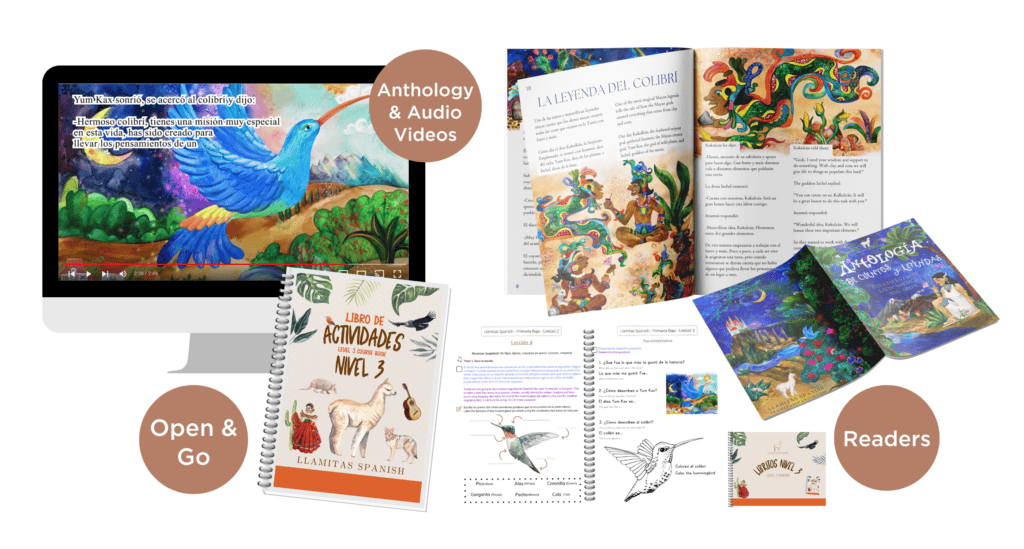In this post: Discover 10 tremendous benefits to growing up bilingual, especially from an early age.
In an age when global communication and worldwide travel have become the norm for many of us, bilingualism is becoming a way of life for a large number of people around the world. And there are definite advantages to being bilingual.

This post contains affiliate links for your convenience. Please read my Disclaimer for more information.
In the United States today, per the US Census Bureau, about 20% of children under age 5 live in bilingual or multilingual households. The language most often spoken in the U.S. after English is Spanish, with over 41 million Spanish speakers extending from California to New York.
While in the past it was thought that speaking more than one language confused children and hindered their academic and intellectual development – particularly in the pre-school years while building essential language skills – a plethora of studies have now demonstrated that there are tremendous benefits to growing up bilingual, especially from an early age.
If you’d like to start your child on their journey to becoming a bilingual global citizen, the best place to begin is by enrolling in our Llamitas Spanish Curriculum and subscribing to our Freebie Library to take advantage of our wonderful list of free resources to enhance your child’s Spanish language education.

Table of Contents
What Does it Mean to be Bilingual?
Bilingualism is simply defined as the ability to speak two languages while being able to distinguish and maintain the correct vocabulary, grammar, and phonetics for each language, even while switching between them.
About 43-45% of the world’s population is bilingual. In the United States, the bilingual population practically doubled between 1980 and 2020, according to an article published in Psychology Today.
Bilingualism benefits society by facilitating cross-cultural communication, while positively affecting cognitive abilities in individuals.
While many countries actually have more than one official language, and about 60-75% of the world’s population speaks at least two languages while growing up, only about 20% of the U.S. population is bilingual, which makes monolingual native English speakers a minority in the world.
Studies have documented that bilingualism has numerous benefits, and we have listed 10 of them below.
Bilingual People Do Better in the Job Market
Not only are bilingual people more desirable on the job market and more likely to be promoted to positions that require international travel, but studies also show that they are often compensated for their language skills, with bilingual employees earning between 5-10% more hourly than their monolingual counterparts.
As these advantages can add up over a person’s career, one study estimated that bilingual employees may earn as much as $128,000 more than their monolingual counterparts over a period of 40 years.
In a study conducted at MIT, economist Albert Saiz found that college graduates working as bilingual professionals earn about 2% higher wages on average than their monolingual peers, which, according to The Economist translates to about $67,000 additional savings that these professionals may apply toward their retirement.
Bilingualism is particularly valuable in careers such as international business, education, national security, public health, tourism, and even careers in the military.
Recently, the US Bureau of Labor Statistics reported that careers in the fields of translation and interpretation are among the fastest growing occupations currently in the United States, with an almost 20% growth rate in the field expected over the next 10 years.
Bilingual Students Do Better in School
Studies have also confirmed that being bilingual results in improved cognitive development and improved attention to detail that may help individuals to better process information in their environment, improving their learning abilities both in daily life and at school.
These benefits begin quite early in a child’s development, as studies have demonstrated that being bilingual is linked to increased attention spans and focus, as well as enhanced conflict management abilities in infants as young as seven months.
Bilingual children are also quicker to adapt to new circumstances, rules, and instructions than their monolingual counterparts, as they exhibit stronger cognitive abilities and general understanding of vocabulary.
Check out our FREE Spanish Resource Library with printable, screen-free materials, music, games, and much more! We add new content every month to help your little linguist become fluent in Spanish faster!

Bilingualism Improves Memory
While many studies have shown that bilingual individuals score higher than their monolingual counterparts when presented with tasks that require the use of memory, Dr. Rubin Abutalebi, a neuropsychologist at the University of San Raffaele in Milan, believes that one can distinguish bilingual from monolingual people simply by looking at their brain scans.
Bilingual people have significantly more gray matter than monolinguals in their anterior cingulate cortex, and that is because they are using it so much more often,” he notes.
Dr. Rubin Abutalebi
Other studies have shown that bilingual and multilingual people also have an easier time remembering such things as names, directions, instructions, and items on a list, and some studies have documented that bilingual people exhibit better planning and problem-solving skills than their monolingual counterparts.
Bilingualism Expands Cultural and Social Opportunities
Being bilingual provides children with opportunities to make new friends with people who speak Spanish and come from Hispanic/Latino backgrounds. They will be able to enjoy books, music, movies, and plays in Spanish. When traveling to Spain or Latin American countries, they will enjoy a much more immersive experience.
Once an individual is fully bilingual, they can communicate directly with locals, ask for directions, bargain for better deals, order food in restaurants, and even get jobs and rent apartments in the locations they travel to! In fact, once an individual is fully bilingual, the world opens up for them, and they can live in the country of their choice!
Get to know some Spanish and Latin American folktales that will help your child develop a better understanding of Hispanic/Latino culture while they study Spanish!

Bilingualism Boosts Confidence!
Bilingualism also makes people more self-confident, and to others, bilingualism is an attractive and desirable personality trait. In fact, a recent study conducted by Babbel, a language software app, found that 71% of Americans and 61% of Britons find someone more attractive and more intelligent if they are bilingual – so bilingualism can even be an asset in the dating world.
Because the process of learning a new language requires overcoming certain risks and expands one’s ability to better understand other people, it naturally enhances confidence and boosts self-esteem, improves communication skills, and enhances one’s ability to move comfortably through the world.
Help your child celebrate their Spanish language skills by singing along to our collection of 20 Classic Spanish and Latin American Songs for Children!
Bilingualism Enhances Long-term Neurological health
In recent decades, researchers have availed themselves of technological advances to more deeply study the human brain and observe how bilingualism affects the cognitive and neurological systems in human beings.
Many studies have found that bilingualism seems to enhance brain health, and that bilingual people typically take an average of 4.5 years longer than monolingual people to develop dementia.
While bilingualism doesn’t prevent the disease, that extra “gray matter” in the brain developed as a consequence of speaking two languages can help to ward off neural deterioration.
Another study performed in India noted that, of 600 stroke survivors, the bilingual individuals in the group recovered their speaking abilities twice as quickly as their monolingual counterparts.
Bilingual People are Better at Multi-tasking
Bilingual people are highly skilled at switching between their two languages, because their brains remain highly tuned in to their surroundings, constantly on the subconscious alert for cues as to which language is appropriate in any context.
According to a study conducted at Penn State University, this keen mental awareness and attunement with their surroundings also makes bilingual individuals more adept at multitasking than their monolingual peers, and even makes them better at driving!
The ability to seamlessly switch between two languages naturally enhances an individual’s ability to switch between two different tasks, as both behaviors trigger the same impulses in the brain.
Bilingual People are More Empathetic
Another study, published in the Journal of Experimental Psychology in 2012, found conclusive evidence that, while people are generally influenced by their own belief system when trying to comprehend others’ beliefs and circumstances, bilinguals were less likely to exhibit this type of cognitive bias, and were more open to understanding others’ perspectives.
Other studies have found that bilingual individuals outperform their monolingual counterparts in tests that assess how well they “read” other people. Many psychologists believe that bilingual individuals are more empathetic because they are more skilled at listening and comprehending others, as their brains tune in more closely to the language the person in front of them is speaking.
In a well-known 2012 study published in Cerebrum, researchers Marian and Shook found that bilingual people also perform better on tasks that require conflict management, thanks to something called inhibitory control.
Inhibitory control is the ability to ignore irrelevant information and focus specifically on the relevant aspects of a situation, and a skill that is also strengthened in the brain by the use of more than one language.
Marian and Shook found that bilingual individuals perform better than their monolingual peers at tasks that demonstrate inhibitory control.
Related post: Expressing Feelings and Emotions in Spanish
Bilingualism Improves Cognitive Abilities
The Marian and Shook study delved into how bilingualism affects the cognitive and neurological systems.
Among their findings, the study demonstrated that, when a bilingual individual speaks in one language, the other language is active in the brain at the same time.
When someone hears a word, they don’t hear the entire word all at once: they hear the sounds in sequential order. Before the word is fully heard, the brain is already anticipating the full word by activating the memory of other words that have the same initial sound.
So, if you hear the sound “can” your brain might anticipate the word “candy” or “cannon” depending on the context. For bilingual people, this activation happens in both languages simultaneously, tapping into both language systems at once.
In a 2008 study published in the Journal of Cognitive Neuroscience, researchers used brain imaging techniques such as functional magnetic resonance imaging (fMRI) to study which regions of the brain are activated when bilingual people perform tasks that required them to switch between their two languages.
For example, when asked to switch between naming pictures in Spanish and naming the same pictures in English, they exhibit increased activity in the dorsolateral prefrontal cortex (DLPFC), a region of the brain associated with cognitive skills such as attention, focus, and inhibition.
The act of switching between languages was also found to activate other areas of the brain such as the anterior cingulate cortex (ACC), that also contribute to cognitive control. The left side of the inferior frontal gyrus (IFG), which is often considered the brain’s language production center, also appears to be activated by alternating languages.
Researchers also found that speaking a second language fluently, and the early acquisition of that second language in childhood, correlates with a higher volume of gray matter in the left inferior parietal cortex of the brain in bilingual people.
This area of the brain is thought to have an important function in managing an individual’s capacity to switch between the two languages. Researchers also found changes in the brain’s white matter volume in both bilingual children and older adults, noting that bilingualism changes not only the way in which neurological structures process data, but may actually alter the form and matter of these neurological structures.
Related posts: Busting the Myths about Raising Bilingual Kids
Bilingualism Protects Against Age-Related Decline
Many of the studies conducted on the brains of bilingual children and adults found that the cognitive and neurological benefits of bilingualism extend from childhood to old age.
Bilingualism appears to help ward off a natural decline of cognitive function and maintaining “cognitive reserve,” which refers to the brain’s ability to efficiently utilize brain networks to enhance brain function during the aging process.
Bilingualism was found to enhance cognitive reserve by supporting the cognitive system and assist in recruiting alternate brain networks when others become damaged as we age. Bilingual elders enjoy better memory and cognitive control when compared to their monolingual counterparts.
In fact, bilingualism may also protect individuals against illnesses such as Alzheimer’s. In 2010, a study published in Neurology of more than 200 bilingual and monolingual patients with Alzheimer’s disease, found that bilingual patients showed initial symptoms of the disease at about 77.7 years of age, or an average of 5.1 years later than their monolingual counterparts, who showed initial symptoms at an average age of 72.6.
Similarly, the bilingual patients in the group were diagnosed 80.8 years of age, or an average of 4.3 years later than their monolingual counterparts who were generally diagnosed around 76.5 years of age.
Giving your child the bilingual advantage
Clearly, the benefits of being bilingual extend from early childhood to old age, and your child’s entire life will be improved by this advantage. In addition to the demonstrated cognitive and neurological benefits, your child will also enjoy valuable social benefits from being bilingual.
To help you get started on your family’s bilingual journey, we’ve created open and go Spanish curricula products to make the process easy! Explore our curricula levels that you can use to make learning Spanish more fun and interactive for the whole familia!


